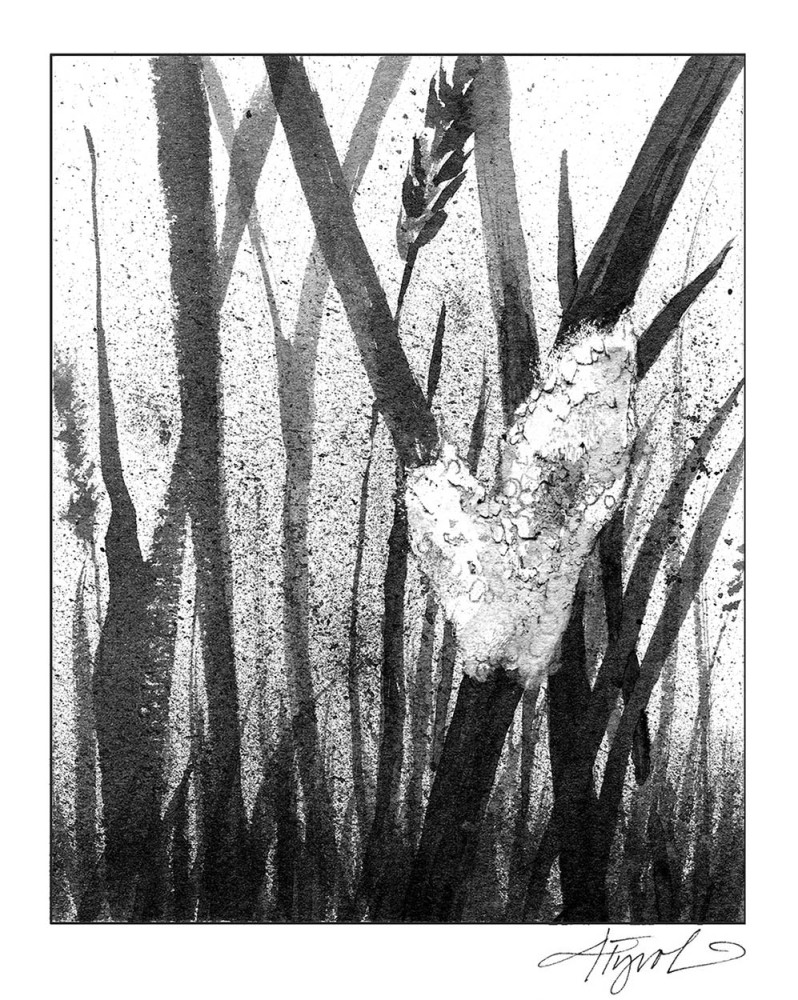
On the lower levels of the food chain, danger is rarely out of spitting distance. Risk from predators has spurred the evolution of many clever adaptations – camouflage coloring, speedy retreat, distasteful secretions, and armor plating among them. Small jumping insects known as froghoppers approach concealment in a unique way: their developing nymphs cover themselves in a bubble bath. From this trick they derive their common name, “spittle bug.”
If you investigate the clumps of white froth, sometimes referred to as ‘cow spit’ or ‘frog spit,’ that appear on plant stems this time of year, you’ll find that each dollop of foam envelops a soft, greenish insect. Who would have thought that froth, so soft and insubstantial, could be protective? Yet predators can’t see the bug for the bubbles, and if they probe the foam, they soon find that it has an acrid taste. The spittle bug’s foam is also a good insulator against heat and cold. And it is a great moisturizer, without which the soft-bodied nymph would soon dry up.
Despite its name, spittle bug “spit” isn’t spit at all, but comes from the other end of the bug. Like all insects in the order Hemiptera (true bugs, not to be confused with the common usage of the word “bug” for insect), spittle bugs feed on plant sap through piercing mouthparts. Worldwide, there are a wide variety of spittlebug species.
Spittlebugs suck sap from the xylem, the long tubular cells that transport water in plant stems; most other sucking insects feed on the phloem that lies close beneath a plant’s outer sheath. Since the xylem sap contains fewer nutrients than the phloem, the spittle bug has to process a lot of fluid to grow.
The bug feeds standing on its head and excretes excess fluid from its anus. This fluid runs down and coats the spittle bug’s body. Specialized glands mix in mucilaginous compounds that increase the viscosity of the fluid and also stabilize the bubbles. The nymph sucks air into its abdominal breathing tube and then forces it out to blow bubbles while pumping its abdomen up and down. As bubbles form, it uses its legs to pull the froth over its body. Safe within this foamy bath, the nymph grows and molts a few times, finally emerging as an adult.
The adult spittlebug, or froghopper, is a rather drab, stubby creature in shades of brown to gray. However, it too has a claim to fame. Although it is a fraction of an inch in length (the common Meadow Spittlebug averages less than a quarter of an inch), this bug can jump more than two feet in the air. This is equivalent to a man leaping over the Gateway Arch in St. Louis. This revelation has established the spittle bug as one of nature’s most powerful jumpers.
The froghopper doesn’t have enormous hind legs, so how does it do it? The mechanism can best be compared to a crossbow. Large internal muscles stretch an elastic structure composed of a substance dubbed resilin. This appears to be the perfect rubber – it can remain stretched to over twice its length for months, and still rebound to its original dimensions. The stretched resilin exerts tension and flexes the bug’s stiff exoskeleton, like flexing a bow. When this tension is released, it powers explosive extension of the rear legs. When not jumping, the bug keeps its rear legs poised for takeoff and only uses its four front legs to walk about.
A jumping frog hopper moves ten times faster than a flea. In fact, the acceleration is so great that the bug is subjected to a force equivalent to 400 times that of gravity. Compare that to a diving fighter plane, which reaches a force equivalent of about ten G. That’s an impressive feat for a little bug, and another great example of an outstanding adaptation to escape predators.

